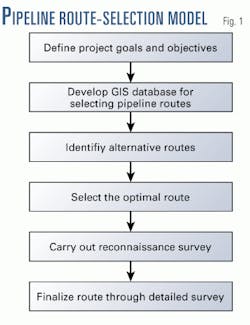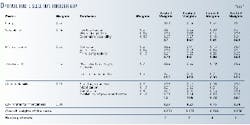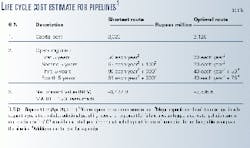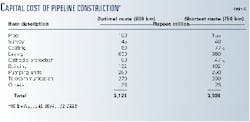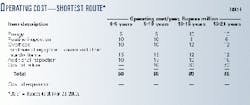Decision-support system yields better pipeline route
Selecting the best pipeline route considers not only the shortest total distance, accessibility, constructability, and governmental stipulations, but also operability, expansion capability, and maintainability.
A decision-support system for pipeline route selection has been developed that applies an analytical hierarchy process (AHP), a multiple attribute decision-making technique.
AHP takes account of all route-selection factors interactively. The system is demonstrated here through a case study of route selection.
A cost-benefit comparison of the shortest route (conventionally selected) and optimal route establishes the effectiveness of the model.
Goals; mistakes
Cross-country petroleum pipeline route selection is governed by the following goals:
- Establish the shortest possible route to connect originating, intermediate, and terminal locations.
- Ensure, as far as practicable, accessibility during operation and maintenance.
- Preserve ecological balance and avoid or minimize environmental damage. The route should be kept clear of forests as much as possible.
- Avoid populated areas.
- Keep rail, road, river, and canal crossings to a minimum.
- Avoid hilly or rocky terrain.
*Avoid a route parallel to high-voltage transmission lines or DC circuits.
- Use existing right-of-way, if possible.
- Avoid such other obstacles as wells, houses, orchards, lakes, or ponds.
A reconnaissance survey must determine these characteristics, always with the uppermost goal to find the shortest possible route.
There are many examples of lost productivity as a result of wrong pipeline route selection.
For example, a specific stretch of pipeline in the eastern part of India (102 km, 12.75 in./324 mm OD, 0.25 in./6.35 mm WT, API 5L X-46 pipe grade) was commissioned in September 1977. The pipeline is protected against external corrosion by impressed current cathodic protection (CP) system in addition to coal-tar enamel external coating.
The right-of-way includes 30 km of an area that remains under 3-4 m of water 6-7 months a year. In this 30-km stretch, extensive external corrosion has occurred.
Between pipeline "chainage" (distance from a reference point) 11 km to 41 km, two leaks were discovered, and at 203 locations sleeving has been carried out because of the heavy external corrosion.
The pipeline operates at lower than designed for throughput. It is estimated that this pipeline incurs a loss of 120 million Rupees/year (approximately $2.77 million), 115 million Rupees for lost production due to operation at a derated capacity plus 5 million Rupees for additional maintenance.
If the pipeline had been rerouted during the initial design phase, the capital cost would have increased by 100 million Rupees (50 million Rupees for additional mainline cost, plus 50 million Rupees additional station). The benefit of alternative route is clear.
Another example of poor route selection is a 40-km stretch of coal belt along the route of a petroleum pipeline in eastern India. This stretch is vulnerable to failure due to third-party activities (coal mining) in the surrounding area.
A risk-analysis study determined that the probability and severity of a failure here were very high, with an expected cost of 1,000 million Rupees.1 Rerouting the pipeline during the design stage would have cost 60 million Rupees. Avoiding this area would have been cost effective.
A petroleum pipeline is designed to carry a specific capacity for specific life period and rely on a forecast of supply-demand scenario of petroleum products. It is quite likely that during a pipeline's life span, however, the capacity of the line may need to be increased to maximize the return commensurate with petroleum product demand. But if the pipeline route provides inadequate room for such an expansion, this cannot be accomplished.
Methodology
The factors that lead to pipeline route selection are both objective and subjective. And they may conflict: achievement of one may result in sacrificing others.
A decision support system for pipeline route selection that considers all factors is needed. This article establishes such a system by applying analytical hierarchy process (AHP).2 We know of no previous use of AHP for selecting pipeline routes.
AHP provides a flexible and easily understood way of analyzing project risks. It is a multiple criteria decision-making methodology that considers subjective and objective factors.
AHP allows active participation of decision-makers in reaching agreement and gives managers a rational basis on which to make decisions.
The process has been used by researchers in various industrial applications.3-5 Formulating the decision problem in a hierarchical structure is the first step.
In a typical hierarchy, the top level reflects the overall objective (focus) of the decision problem. The elements affecting the decision are represented in intermediate levels. The lowest level consists of the decision options.
Once the hierarchy has been constructed, the decision-maker begins prioritizing the relative importance of the elements in each level of the hierarchy. The elements in each level are compared pair-wise based on their importance in the decision under consideration.
The verbal scale used in AHP enables the decision-maker intuitively to incorporate subjectivity, experience, and knowledge. After the comparison matrices have been created, the process moves on to the phase in which relative weights are derived for the various elements.
The weights of the elements of each level relative to elements in the adjacent upper level are computed as the components of the normalized eigenvector associated with the largest eigenvalue of their comparison matrix.
The composite weights of the decision alternatives are then determined by an aggregation of the weights through the hierarchy. This is done by following a path from the top of the hierarchy to each alternative at the lowest level, and multiplying the weights along each segment of the path.
The outcome of this aggregation is a normalized vector of the overall weights of the options. The mathematical basis for determining the weights has been established.2
The following methodology has been adopted in selecting optimal pipeline routes.
- Identification of alternative routes.
- Preparation of strong database for each route.
- Identification of the factors and subfactors leading to pipeline route selection.
- Formulation of risk structure in line with AHP requirements.
- Pair-wise comparison of factors and subfactors to determine the importance of factors and subfactors in selecting the route.
- A Pair-wise comparison of alternatives, with respect to each sub-factor, to determine the benefits of one route over another.
- Synthesizing the results across the hierarchy to determine the optimal route.
Application
The entire methodology is illustrated in a case of selecting the optimal pipeline route for a project in southern India. Fig. 1 shows the proposed route-selection model.
Use of geographic information systems (GIS) in pipeline-route selection has been explained by Montemurro.6 Table 1 shows the database pertaining to all four routes.
The next step is to identify the factors and sub-factors that lead to selecting a certain route. The checklist method7 was adopted.
An exhaustive list of factors that led to picking a route was shown to executives working on route selection. They identified factors that were relevant for this project:
- Pipeline length. The most critical factor in selection of a route is its length, because the capital cost of a pipeline depends mostly on length.
- Operability. The hydraulic gradient is a major factor in selecting prime mover power for pipeline operation. Similarly, more route diversion causes more friction loss, resulting in higher prime mover power for the same throughput.
A pipeline is designed for specific throughput in line with demand; a pipeline may need to be expanded in the future to cope with the demand for maximizing profit. Therefore, expansion capability is one attribute of a good pipeline.
In addition to improving the existing prime mover capacity, a pipeline can also be expanded by installing more pumping stations along the route. Therefore, the pipeline route should be chosen with a view to its expansion capability.
- Maintainability. Although pipelines are designed with adequate safety factors, they are subject to failure due to various reasons. Pipeline corrosion, vandalism, and third-party activities that lead to significant product loss and consequent disaster.8 9
Therefore, these factors should be carefully considered during the feasibility study. In a decision model, these factors may influence the selection of a specific route.
- Accessibility. Although a cross-country petroleum pipeline is buried, the right-of-way should allow uninterrupted construction activities as well as operation, inspection, and maintenance.10
The ideal pipeline route should be along a railway track or a major highway. This is not, however, always possible because the long length of some pipelines that may require river crossings and travel through forests or deserts.
- Constructability. Laying a pipeline across state, provincial, or national boundaries requires permission from governmental authorities. Stringent safety and environmental stipulations sometimes hinder project activities.
Mobilization is a major construction activity. One factor in pipeline routing is provision for effective mobilization by the contractor. Distance to market, availability of power and water, and the number of unskilled laborers are typical requirements for starting construction.
Pipeline construction methods vary greatly with terrain conditions. For example, laying pipeline across a river increasingly requires horizontal direction drilling (HDD), while laying across rocky area requires rock trenching.
Therefore, location characteristics are a major cost component of pipeline construction. Inappropriate route selection can cause major time and cost overruns.
- Environmental issues. Although pipelines that handle hazardous petroleum products are designed with safety features, failure is not uncommon. Sometimes failures result in a release of large quantities of petroleum products into the environment. Should this happen, a pipeline in a remote area poses less of a safety concern.
The next step in the methodology is to form a risk structure in an AHP framework. Fig. 2 shows the AHP model for selecting an optimal route. Factors and sub-factors are compared pair-wise on a scale of 1 to 9 to form matrices that lead to the determination of weights for the factors and sub-factors.
Table 2 shows the scale of relative importance for a pair-wise comparison. Table 3 depicts a pair-wise comparison matrix for these factors.
Alternate routes are compared pair-wise, with respect to each sub-factor, and as a preference over the other. Subsequently, synthesizing the weight of each factor/sub-factor across the hierarchy results in determining the final weights of pipeline routes and ranking them.
Table 4 shows the output (weights) of matrix operation and overall ranking of possible pipeline routes.
Findings
This study indicates that pipeline Route 4 is ranked highest. Although longer than the other three, this route outranks them because of its expansion capability and maintainability through out its life cycle.
Table 5 shows the life cycle cost estimate (Route 3, the shortest route, and Route 4, the optimal route). Tables 6-8 show the break out of capital and operating costs, respectively. (Source for cost data is the detailed feasibility report for the pipeline project in southern India based on other recently completed projects and quotations from vendors.)
The net present value (NPV) of the optimal route is much higher than the shortest route. This validates the applicability of the model of pipeline route selection model.
Advantages
Because petroleum pipelines are capital-intensive, the present design practice all too often is to select routes simply on the basis of the shortest distance. Life-cycle analysis, however, may reveal a greater profit from alternate longer routes.
Route selection should be based on a detailed study of alternatives that considers all factors. The selection model presented here has the following advantages:
- It allows the incorporation of interactive input by executives from related functional areas.
- It helps make objective decisions.
- It incorporates both tangible and intangible elements via the AHP hierarchies. Qualitative and subjective judgments, as well as quantitative data can be included in the priority-setting process.
- AHP is effective for conducting group sessions analytically and systematically. There are multiple ways of including the subjective judgments of many persons.
- The model allows the collection of more information about the detailed engineering stage.
- Sensitivity analysis provides decision-makers with a knowledge of the effects of their decisions.
Use of this model requires more information and may result in a higher initial cost. The benefits, however, compensate.
References
- Annual Report of CONCAWE (Conservation of Clean Air and Water, Europe), Brussels, 1994.
- Saaty, T.L., The Analytic Hierarchy Process, New York, McGraw Hill, 1980.
- Mian, S.A., and Dai C.X., "Decision-making over the project life cycle: An analytic hierarchy approach," Project Management journal, Vol. 30, No. 1 (1999), pp. 40-52.
- Mustafa, M.A., and Ryan, T.C., "Decision Support Bid Evaluation," International Journal of Project Management, Vol. 8, No. 4 (1990), pp. 230-35.
- Dey, P.K., Tabucanon, M.T., and Ogunlana, S.O., "Planning for project control through risk analysis: A case of Petroleum Pipeline Laying Project," International Journal of Project Management, Vol. 12, No. 1, 1994, pp. 23-23.
- Montemurro, D., and Barnett, S., "GIS-based process helps TransCanada select best route for expansion line," OGJ, June 22, 1998, p. 63.
- Cooper, D.F., and Chapman, C.B., Risk Analyses for Large Projects: Models, Methods and Cases, New York: John Wiley, 1986.
- Dey, P.K., Ogunlana, S.O., Gupta, S.S., and Tabucanon, M.T., "A Risk Based Maintenance Model for Cross-country Pipelines," Cost Engineering, Vol. 40, No. 4, April 1998, pp. 24-31.
- US Department of Transportation. Pipeline Safety Regulation, Oct. 1, 1995.
- Dey, P.K., Tabucanon, M.T., and Ogunlana, S.O., "Petroleum pipeline construction planning: A conceptual framework," International Journal of Project Management, Vol. 14, No. 4 1996, pp. 231-40.
The authors-
Prasanta K. Dey is a member of the faculty the Department of Management Studies of University of the West Indies, Cave Hill campus, Barbados.
Previously, he was with the pipeline division of Indian Oil Corp. Ltd., New Delhi. He worked there for 14 years in various pipeline projects from concept to commissioning. He obtained a doctorate (1997) in project management from Jadavpur University, Calcutta, a masters (1992) in industrial engineering and management from the Asian Institute of Technology, Bangkok, and a bachelors (1985) in mechanical engineering from Jadavpur University.
Saumitro Sankar Gupta is an inspection manager in the pipeline division of Indian Oil Corp. Ltd., Noida. He joined Indian Oil in 1985 and was named to his present position in 1998. Gupta holds a bachelors (1984) from Punjab University, Chandigarh, India, in metallurgical engineering.
